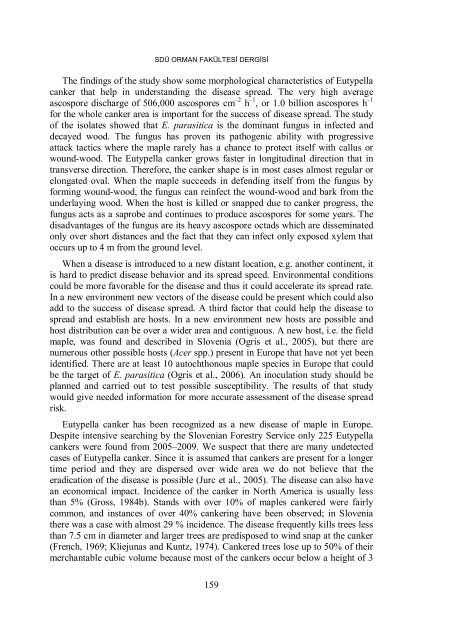sdu faculty of forestry journal special edition 2009 - Orman Fakültesi
sdu faculty of forestry journal special edition 2009 - Orman Fakültesi
sdu faculty of forestry journal special edition 2009 - Orman Fakültesi
Create successful ePaper yourself
Turn your PDF publications into a flip-book with our unique Google optimized e-Paper software.
SDÜ ORMAN FAKÜLTESİ DERGİSİ<br />
The findings <strong>of</strong> the study show some morphological characteristics <strong>of</strong> Eutypella<br />
canker that help in understanding the disease spread. The very high average<br />
ascospore discharge <strong>of</strong> 506,000 ascospores cm –2 h –1 , or 1.0 billion ascospores h –1<br />
for the whole canker area is important for the success <strong>of</strong> disease spread. The study<br />
<strong>of</strong> the isolates showed that E. parasitica is the dominant fungus in infected and<br />
decayed wood. The fungus has proven its pathogenic ability with progressive<br />
attack tactics where the maple rarely has a chance to protect itself with callus or<br />
wound-wood. The Eutypella canker grows faster in longitudinal direction that in<br />
transverse direction. Therefore, the canker shape is in most cases almost regular or<br />
elongated oval. When the maple succeeds in defending itself from the fungus by<br />
forming wound-wood, the fungus can reinfect the wound-wood and bark from the<br />
underlaying wood. When the host is killed or snapped due to canker progress, the<br />
fungus acts as a saprobe and continues to produce ascospores for some years. The<br />
disadvantages <strong>of</strong> the fungus are its heavy ascospore octads which are disseminated<br />
only over short distances and the fact that they can infect only exposed xylem that<br />
occurs up to 4 m from the ground level.<br />
When a disease is introduced to a new distant location, e.g. another continent, it<br />
is hard to predict disease behavior and its spread speed. Environmental conditions<br />
could be more favorable for the disease and thus it could accelerate its spread rate.<br />
In a new environment new vectors <strong>of</strong> the disease could be present which could also<br />
add to the success <strong>of</strong> disease spread. A third factor that could help the disease to<br />
spread and establish are hosts. In a new environment new hosts are possible and<br />
host distribution can be over a wider area and contiguous. A new host, i.e. the field<br />
maple, was found and described in Slovenia (Ogris et al., 2005), but there are<br />
numerous other possible hosts (Acer spp.) present in Europe that have not yet been<br />
identified. There are at least 10 autochthonous maple species in Europe that could<br />
be the target <strong>of</strong> E. parasitica (Ogris et al., 2006). An inoculation study should be<br />
planned and carried out to test possible susceptibility. The results <strong>of</strong> that study<br />
would give needed information for more accurate assessment <strong>of</strong> the disease spread<br />
risk.<br />
Eutypella canker has been recognized as a new disease <strong>of</strong> maple in Europe.<br />
Despite intensive searching by the Slovenian Forestry Service only 225 Eutypella<br />
cankers were found from 2005–<strong>2009</strong>. We suspect that there are many undetected<br />
cases <strong>of</strong> Eutypella canker. Since it is assumed that cankers are present for a longer<br />
time period and they are dispersed over wide area we do not believe that the<br />
eradication <strong>of</strong> the disease is possible (Jurc et al., 2005). The disease can also have<br />
an economical impact. Incidence <strong>of</strong> the canker in North America is usually less<br />
than 5% (Gross, 1984b). Stands with over 10% <strong>of</strong> maples cankered were fairly<br />
common, and instances <strong>of</strong> over 40% cankering have been observed; in Slovenia<br />
there was a case with almost 29 % incidence. The disease frequently kills trees less<br />
than 7.5 cm in diameter and larger trees are predisposed to wind snap at the canker<br />
(French, 1969; Kliejunas and Kuntz, 1974). Cankered trees lose up to 50% <strong>of</strong> their<br />
merchantable cubic volume because most <strong>of</strong> the cankers occur below a height <strong>of</strong> 3<br />
159








